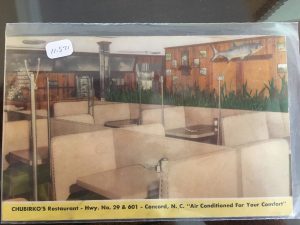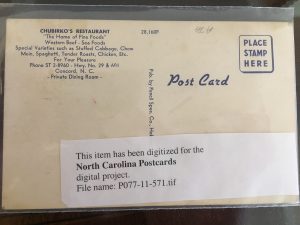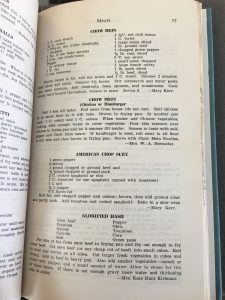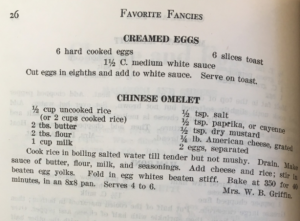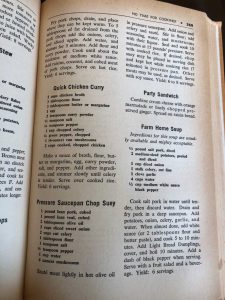1950s
North Carolina Chinese Restaurants in the 1950s
By Elisabeth Molnar, Jason Guo, Ana Morris
What was going on during this time?
1947-1957 – The Red Scare
In the United States, intense fear of the spread of communism to the U.S. followed the beginning of the Cold War and the establishment of communist governments in China and many other countries. Led by Senator Joseph McCarthy, public figures and politicians deemed to be communist sympathizers lost their jobs and were blacklisted.
June 1950 – The Korean War Breaks Out
On June 25th, the North Korean People’s Army invaded South Korea. The United Nations and the United States took South Korea’s side and China was in support of the communist North. China counterattacked when U.S., UN, and South Korean troops approached the Chinese border. This conflict resulted in the death of 4 million people.
August 1954 – First Taiwan Strait Crisis
In 1954, President Dwight Eisenhower lifted the U.S. naval blockade of Taiwan, which led Chiang Kai-shek to deploy thousands of troops to the Matsu and Quemoy islands (located in the Taiwan Strait). As a result, Mainland China’s People’s Liberation Army shelled the islands. In the spring of 1955, the United States threatened a nuclear attack on China, but China agreed to negotiate.
Documents from this Time Period
click to enlarge photos
Source: North Carolina Collection, Wilson Library, UNC
This postcard is from between 1940 and 1960. The restaurant is called Chubirko’s Restaurant and is located in Concord, NC. Based off of the interior decorations and the list of foods on the back of the postcard including western beef and spaghetti, the restaurant does not appear to be a Chinese restaurant. However, under its list of special variety foods that it serves, the restaurant includes Chow Mein along with popular American dishes. The advertisement of this dish shows that the restaurant believes that this Chinese dish is a desirable option to people in the Concord area and will attract customers to the restaurant. The restaurant on this postcard appears to have the idea that by including Chow Mein, it will have a wider variety of dishes from different backgrounds and will therefore be more appealing to the audience, increasing its business. However, there is only one Chinese dish on the list of foods, potentially indicating that the genre is not as popular as the other food genres listed.
click to enlarge photos
Source: North Carolina Collection, Wilson Library, UNC
These recipes are from Favorite Fancies Cook Book published sometime in the 1950s. The cookbook is from Pleasant Garden, NC. Along with a lot of standard American dishes in the cookbook, we found some Chinese-related dishes. The recipes include Chow Mein, American Chop Suey, Chinese Omelet, and Oriental Salad. The word choices like “American” Chop Suey, “Chinese” Omelet, and “Oriental” Salad used to describe these dishes is interesting. The Chop Suey recipe includes spaghetti and bacon fat. The recipe for the Oriental Salad and the Chinese Omelet appear to have nothing particularly Chinese about them with the exception of using ginger and rice respectively as ingredients. These recipes do not seem like they bare very much resemblance to food actually eaten in China during this time. It shows the 50s lack of knowledge as to what Chinese food is really like. However, since their are multiple Chinese-related recipes in the cookbook, it shows that Chinese food is still on the radar of the people of Pleasant Garden in the 50s, and that they are interested in trying to cook Chinese food. This cookbook also seemed to have a lot more Chinese recipes compared to the other cookbooks from North Carolina in the 1950s that we found in Wilson Library.
click to enlarge photo
Source: North Carolina Collection, Wilson Library, UNC
This recipe was featured in the Southern Cookbook, published in 1961. The majority of the dishes are dishes that are home to the South, but we discovered an interesting feature of a Chinese recipe for Pressure Saucepan Chop Suey. Similar to the recipes included in the Favorite Fancies Cook Book mentioned above, the recipe does not seem to resemble actual Chinese food, but resembles a very simplified, Chinese-American style. As we learned in class, Chop Suey as served in America is nothing like the original version in China, although it is still considered Chinese food by Americans. The recipe says to be served with rice and soy sauce, two ingredients that are common in Chinese cooking, making the recipe more “Chinese” to the southerners reading this cookbook in the 1960s, and thereby distinguishing the dish from other southern recipes in the cookbook.
Research Method: First, we searched through Durham county phone books and city directories in Wilson Library for restaurants that sounded Chinese. We only found the Oriental Restaurant. Then we searched the name of the Oriental Restaurant in the digitalnc.org newspaper section and found a couple of mentions of the restaurant. Upon googling the name of the Oriental, we found a website that had more information and documents on the restaurant. After that, we searched the UNC library system for North Carolina Cookbooks and then ordered our search by date, focusing on the cookbooks from the 1950s. We had to search through a couple of cookbooks, but found some that contained Chinese dishes. We also searched “Chow Mein” into the library system and found the above postcard.
